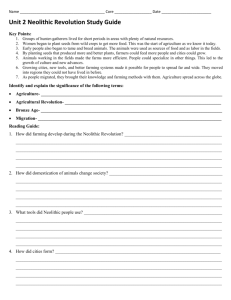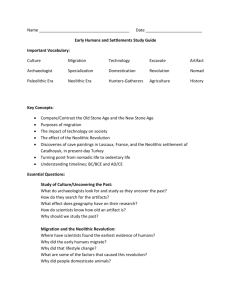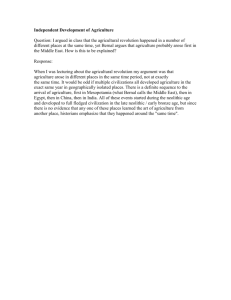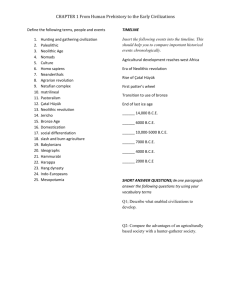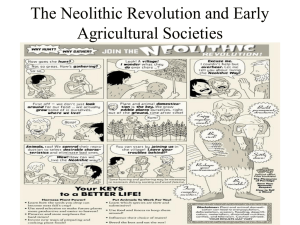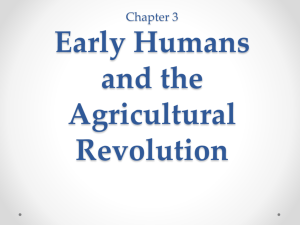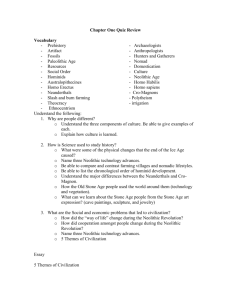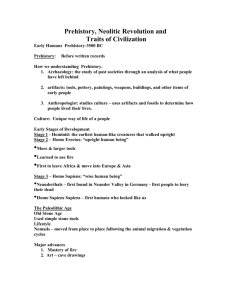WH_ch01_s2
advertisement
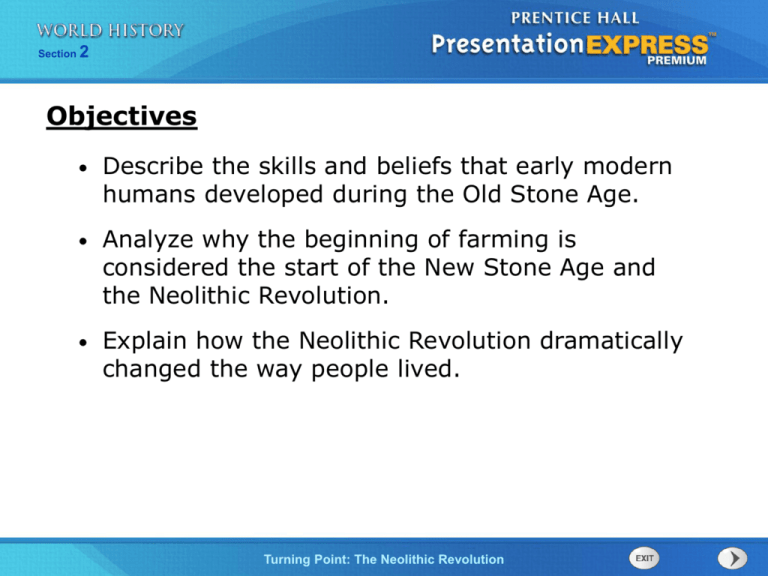
Section 2 Objectives • Describe the skills and beliefs that early modern humans developed during the Old Stone Age. • Analyze why the beginning of farming is considered the start of the New Stone Age and the Neolithic Revolution. • Explain how the Neolithic Revolution dramatically changed the way people lived. Turning Point: The Neolithic Revolution Section 2 Terms and People • Old Stone Age – the era of prehistory from 2 million B.C. to around 10,000 B.C. • Paleolithic Period – the Old Stone Age period • New Stone Age – the period from 10,000 B.C. to the end of prehistory • Neolithic Period – the New Stone Age period • nomad – person who moves from place to place • animism – the belief that spirits and forces reside in animals, objects, or dreams Turning Point: The Neolithic Revolution Section 2 Terms and People (continued) • Neolithic Revolution – the transition from nomadic life to settled farming • domesticate – to raise plants or animals in a controlled way that makes them best suited for human use • Çatalhüyük – an early Neolithic village (around 7000 B.C.) unearthed in modern-day Turkey • Jericho – walled Neolithic village (around 10,000– 9000 B.C.) which exists today as an Israeli-controlled city Turning Point: The Neolithic Revolution Section 2 How was the introduction of agriculture a turning point in prehistory? The period from 2 million B.C. to 10,000 B.C. is referred to as the Paleolithic Period or Old Stone Age. From 10,000 B.C. to the end of prehistory is referred to as Neolithic Period or New Stone Age. During the New Stone Age, new skills and technologies led to dramatic changes in people’s lives. Turning Point: The Neolithic Revolution Section 2 Old Stone Age humans depended heavily on their environment for food and shelter. • They lived in nomadic bands of 20 to 30 people. • Men hunted or fished. • Women and children gathered berries, fruit, nuts, grains, roots, or shellfish. Turning Point: The Neolithic Revolution Section 2 Early modern humans needed to develop technology and strategies for survival. • They made tools and weapons from stone, wood, or bone. • To cook, they used fire. • They used animals skins for clothing. • The development of language allowed for cooperation and planning. Turning Point: The Neolithic Revolution Section 2 Creating tools, such as a stone axe, required patience, skill, and strength. Using a hard stone, the toolmaker struck flakes off of another stone to create the rough shape. A piece of bone was used to refine the tool’s shape. Turning Point: The Neolithic Revolution A small chisel was used to chip the final flakes off the stone. Section 2 Old Stone Age people learned to travel across water. This helped humans to spread to new regions. • Some traveled by raft or canoe from Southeastern Asia to Australia at least 40,000 years ago. • They may have stayed for years on some islands. • They traveled up to 40 miles on the open ocean at a time. Turning Point: The Neolithic Revolution Section 2 Toward the end of the Old Stone Age a belief in a spiritual world developed. • 100,000 years ago some groups began carefully burying their dead. • Tools, weapons, and other goods were provided, indicating belief in an afterlife. • They probably believed in a world full of spirits and forces residing in animals, objects, and dreams—animism. Turning Point: The Neolithic Revolution Section 2 Cave and rock art portrayed animals they relied on, such as deer, horses, and buffalo. Some paintings were found deep in caves, perhaps painted in animist religious rituals. Turning Point: The Neolithic Revolution Section 2 The New Stone Age or Neolithic Period began when people started farming about 12,000 years ago. • People began domesticating plants and animals, raising them for human use. • Food or skins were more available. • This Neolithic Revolution, the transition from nomadic life to settled farming, brought dramatic changes, such as the first permanent villages. Turning Point: The Neolithic Revolution Section 2 Farming began at roughly the same time in different areas, but different plants and animals were domesticated in each region. Western Asia China Southeast Asia sheep, goats, pigs, and cattle millet and rice yams Middle East West Africa Central America barley, chickpeas, peas, lentils, and wheat yams squash South America llamas and alpacas Turning Point: The Neolithic Revolution Section 2 Jericho, which still exists as a city today, was a large, walled village built between 10,000 B.C. and 9000 B.C. • Several thousand people lived in an area only a few soccer fields in size. • A surrounding wall suggests there was a government or leader able to organize a large construction project. Turning Point: The Neolithic Revolution Section 2 Çatalhüyük, an early Neolithic village in modern-day Turkey, may have had 6,500 inhabitants living in rectangular mud-brick homes. Turning Point: The Neolithic Revolution Section 2 In settled Neolithic farming communities, work was probably divided by gender and age. • Male family heads formed councils of elders to decide when to plant and harvest. • When food was scarce, warfare increased, leading to an elite group of male warriors. Differences in wealth appeared as some accumulated more possessions than others. Turning Point: The Neolithic Revolution Section 2 Villagers invented new forms of technology. • Crops needed to be protected and seed measured out for the next harvest. • Time for planting and harvesting had to be measured, leading to calendars. • Draft animals such as oxen or water buffalo were needed for work. Turning Point: The Neolithic Revolution Section 2 Various technologies developed at different rates in different regions. • More complex tools were created in village workshops. • Cloth was woven from vegetable fiber or animal hair. • Clay was used to create pottery for cooking and storage. Knowledge of some technologies traveled from area to area. Others were invented separately. Turning Point: The Neolithic Revolution Section 2 The Neolithic Revolution brought dramatic changes to human life. Settled farming led to the establishment of the first villages. This led to the first cities and civilizations. Dogs were probably first domesticated about 13,000 B.C. Turning Point: The Neolithic Revolution Section 2 Section Review QuickTake Quiz Know It, Show It Quiz Turning Point: The Neolithic Revolution
